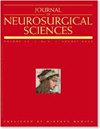Endoscopic endonasal obliteration of the frontal recess and anterior skull base.
IF 1.3
4区 医学
Q4 CLINICAL NEUROLOGY
引用次数: 0
Abstract
BACKGROUND Although endoscopic techniques have become more widespread in repair of frontal sinus (FS) defects, certain pathologies still require open approach (extensive trauma or tumors). Under certain circumstances even multiple complex open reconstructive procedures might fail to resolve persistent pneumocephalus or CSF leak and subsequently surgeons tend to escalate the invasiveness and employ even more complex and aggressive approaches. We present our experience treating persistent pneumocephalus or CSF leak after previously failed transcranial reconstruction utilizing an endoscopic endonasal approach (EEA). METHODS We retrospectively reviewed a prospectively maintained database of all patients undergoing an EEA for repair of persistent pneumocephalus or CSF leak following FS cranialization between 2016 and 2020. RESULTS Six patients who underwent cranialization of the FS with subsequent persistent pneumocephalus or CSF leak were identified; two patients suffered a traumatic fracture of the FS, remaining four patients had undergone previous cranial surgery. Clear violation of the FS was not recognized in one patient. All patients underwent cranialization of the FS either directly following initial craniotomy or during open repair of a FS fracture. Two patients underwent multiple transcranial surgeries including using vascularized free tissue transfer. Complete cessation of pneumocephalus/CSF leak was achieved in 83.3% (5/6) after the first and 100% (6/6) after two endoscopic procedures. No morbidity or mortality resulted from the endoscopic procedure. CONCLUSIONS Skull base defects following a failed cranialization of FS are usually located in or in close proximity to the frontal recess. These defects can be safely and effectively repaired via an EEA.额部凹陷和前颅底的内窥镜内腔阻塞术。
背景虽然内窥镜技术在额窦(FS)缺损修复中的应用越来越广泛,但某些病理情况(大面积创伤或肿瘤)仍需要开颅手术。在某些情况下,即使是多次复杂的开放重建手术也可能无法解决顽固性气胸或 CSF 漏的问题,因此外科医生倾向于增加创伤,采用更复杂、更激进的方法。方法我们回顾性地查看了一个前瞻性维护的数据库,该数据库收录了 2016 年至 2020 年间接受 EEA 修复 FS 颅骨化手术后持续性气胸或 CSF 漏的所有患者。结果6名患者接受了FS开颅术,随后出现了持续性气胸或CSF漏;其中2名患者的FS发生了外伤性骨折,其余4名患者之前接受过开颅手术。有一名患者的前颅底骨折未被确认。所有患者都在最初的开颅手术后直接接受了前颅骨固定术,或在前颅骨骨折的开放性修复过程中接受了前颅骨固定术。两名患者接受了多次经颅手术,包括使用血管化游离组织转移。83.3% 的患者(5/6)在第一次内窥镜手术后完全停止了气胸/脑脊液渗漏,100% 的患者(6/6)在两次内窥镜手术后完全停止了气胸/脑脊液渗漏。结论FS开颅失败后的颅底缺损通常位于额部凹陷处或靠近额部凹陷处。这些缺损可以通过 EEA 安全有效地修复。
本文章由计算机程序翻译,如有差异,请以英文原文为准。
求助全文
约1分钟内获得全文
求助全文
来源期刊

Journal of neurosurgical sciences
CLINICAL NEUROLOGY-SURGERY
CiteScore
3.00
自引率
5.30%
发文量
202
审稿时长
>12 weeks
期刊介绍:
The Journal of Neurosurgical Sciences publishes scientific papers on neurosurgery and related subjects (electroencephalography, neurophysiology, neurochemistry, neuropathology, stereotaxy, neuroanatomy, neuroradiology, etc.). Manuscripts may be submitted in the form of ditorials, original articles, review articles, special articles, letters to the Editor and guidelines. The journal aims to provide its readers with papers of the highest quality and impact through a process of careful peer review and editorial work.
 求助内容:
求助内容: 应助结果提醒方式:
应助结果提醒方式:


